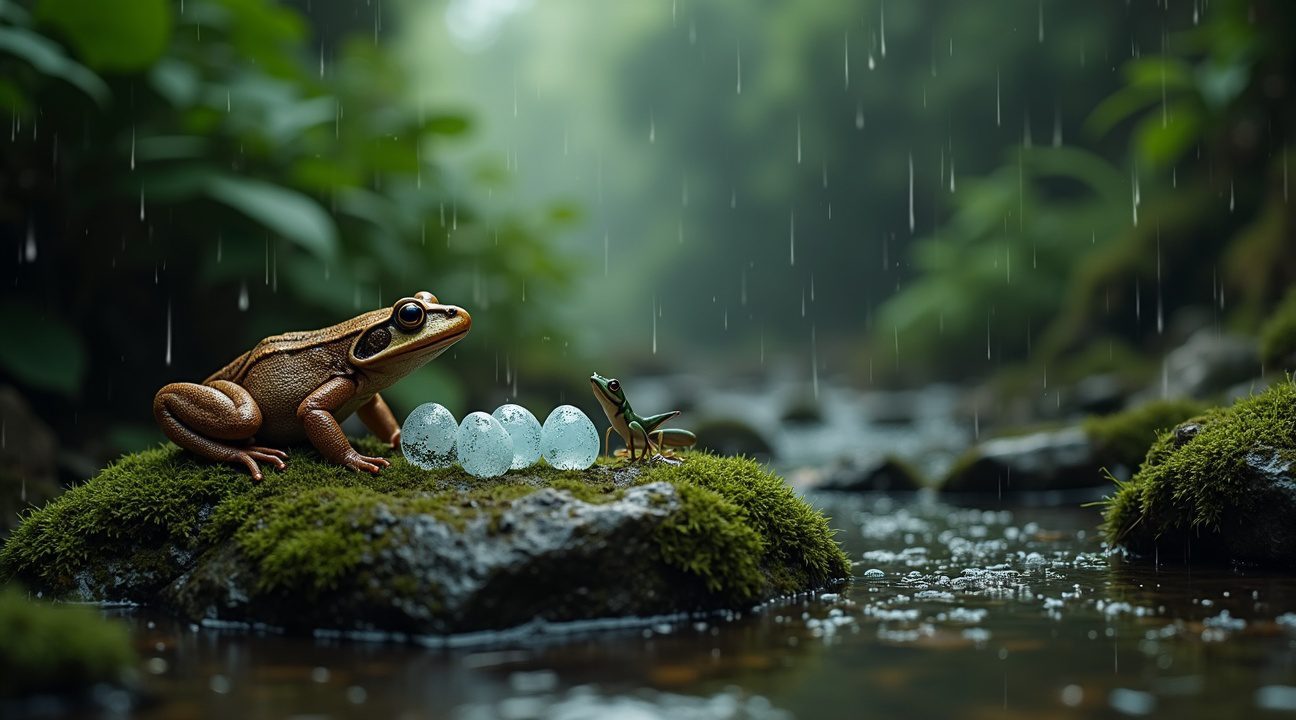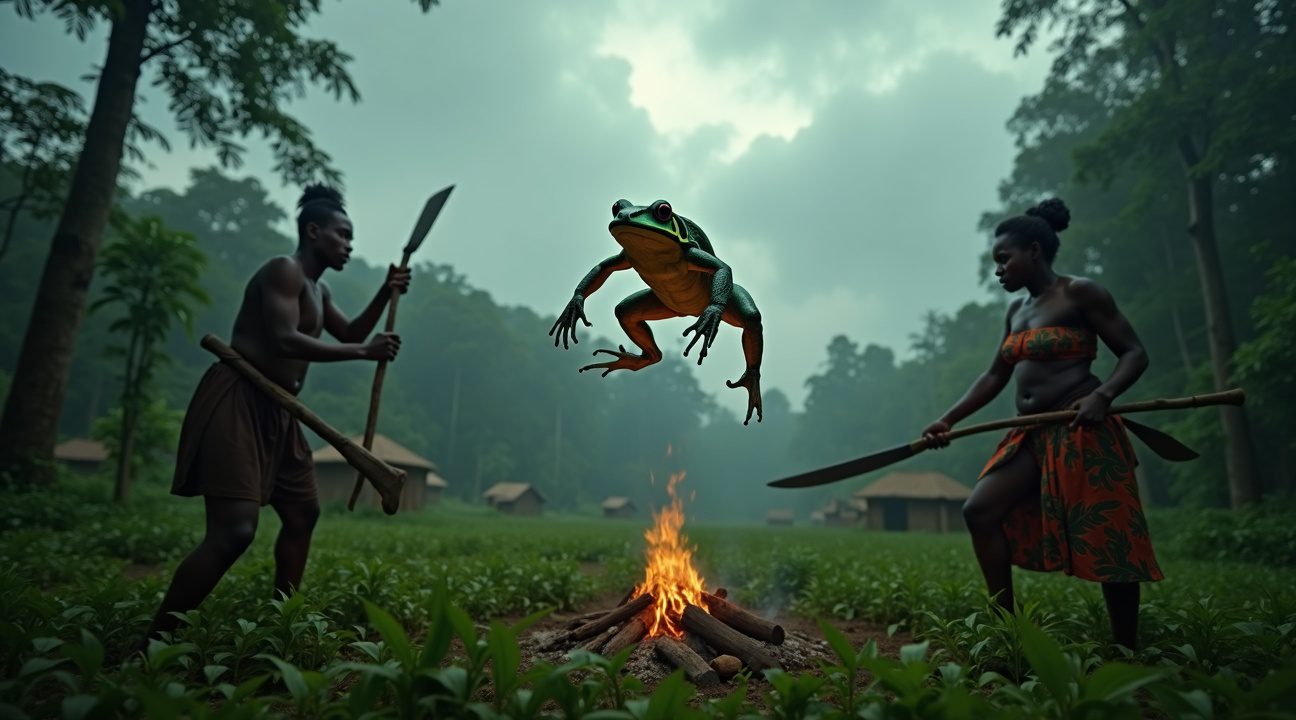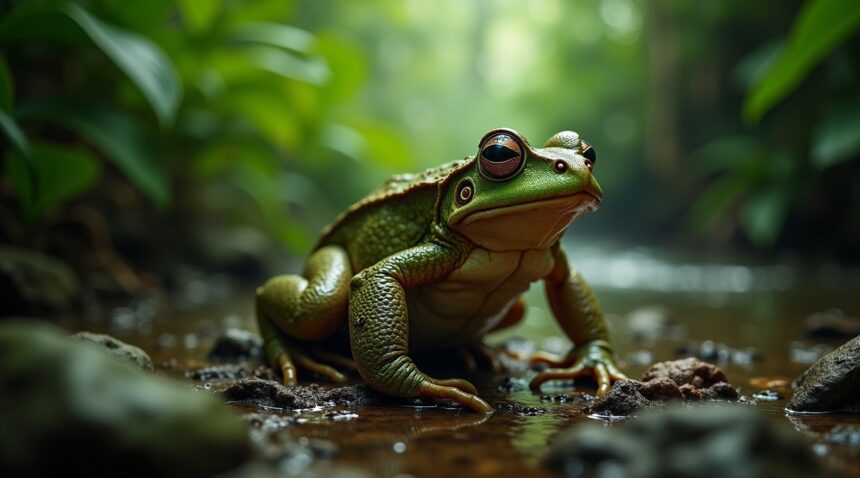The wolverine frog stands out as one of Africa’s most extraordinary amphibians, earning its name through a bone-breaking defensive mechanism that rivals fictional superheroes and seasonal hair-like structures that enhance underwater breathing during breeding season.
This remarkable Central African species, scientifically known as Astylosternus robustus, demonstrates nature’s incredible ability to develop extreme adaptations for survival. From deliberately fracturing its toe bones to create makeshift claws, to growing specialized skin structures that function as external gills, the wolverine frog is a marvel of amphibian evolution.
Key Takeaways
- The wolverine frog deliberately breaks bones in its toes when threatened, forcing sharp bone fragments through its skin to create functional defensive claws.
- Males develop hair-like dermal papillae during breeding season that increase surface area for oxygen absorption, allowing extended underwater periods while guarding eggs.
- The species inhabits Central African rainforests across six countries and demonstrates remarkable adaptability to various environments from pristine forests to human-modified landscapes.
- Local Bakossi communities in Cameroon believe wolverine frogs possess fertility-enhancing properties and use traditional hunting methods to capture them for medicine and food.
- Despite facing threats from habitat loss, water pollution, and disease, the species maintains a “Least Concern” conservation status due to its wide distribution and stable populations.
Additional Insights
The wolverine frog is a standout member of the Astylosternus genus, often referred to as the “hairy frog” due to the male’s unique breeding adaptations. These extraordinary traits have not only fascinated biologists but have also contributed to cultural legends throughout Central Africa. As research continues, this species may offer insights into both evolutionary biology and traditional ecological knowledge.
The Bone-Breaking Defense Mechanism That Makes This Frog Legendary
I’ve studied many fascinating amphibian adaptations throughout my career, but the wolverine frog’s defensive strategy stands out as one of nature’s most extreme examples of self-harm for survival. This remarkable creature deliberately breaks bones in its toes when facing danger, forcing sharp bone fragments through its skin to create makeshift weapons.
How the Bone Claw System Works
The wolverine frog’s retractable claws differ fundamentally from those found in mammals. Instead of keratin-based structures like Sonic the Hedgehog or cat claws, these defensive tools consist entirely of bone. When a predator threatens the frog, specialized muscles contract to snap the toe bones at predetermined fracture points. The sharp bone fragments then pierce through the toe pads, creating functional claws that can inflict serious damage on attackers.
This defensive adaptation earned the species its common name due to obvious similarities with the Marvel character’s metal claws. However, unlike fictional superheroes, the wolverine frog must endure the pain and potential infection risks that come with repeatedly breaking its own bones. The claw deployment appears to be a last-resort mechanism, triggered only when escape isn’t possible.
Seasonal Breathing Adaptations
Male wolverine frogs develop another extraordinary feature during breeding season that showcases their remarkable adaptability. Hair-like structures called dermal papillae emerge along their flanks and thighs, creating what looks like a fuzzy exterior coating. These structures serve a critical function for cutaneous respiration, allowing males to extract oxygen directly from water through their skin.
The dermal papillae significantly increase the surface area available for gas exchange, enabling males to remain submerged for extended periods while guarding their eggs. This adaptation proves essential during the breeding season when males must stay underwater to protect their developing offspring from predators and environmental threats. The increased respiratory capacity through these specialized skin structures allows them to maintain their vigilant watch without frequent trips to the surface for air.
Scientists have observed that the density and length of these papillae can vary between individuals, suggesting that some males may be better adapted for extended underwater periods than others. This variation could provide certain breeding advantages, as males capable of longer submersion times might successfully protect more offspring. Just as space exploration requires innovative life support systems, the wolverine frog has evolved its own biological breathing apparatus for aquatic survival.
https://www.youtube.com/watch?v=tYa6Olz6cR0
Meet the Hairy Frog: Multiple Names for One Remarkable Amphibian
I find it fascinating that this distinctive Central African amphibian goes by several striking names, each highlighting different aspects of its remarkable nature. The wolverine frog earns its primary common name “hairy frog” from the unique hair-like dermal papillae that grow on males during breeding season. Horror frog and wolf frog serve as additional monikers that capture people’s reactions to this species’ more unsettling characteristics.
Scientists originally classified this amphibian as Trichobatrachus robustus, though recent taxonomical research indicates a shift to Astylosternus robustus. This change reflects evolving understanding of the species’ genetic relationships within the Arthroleptidae family. The family classification places these frogs among a diverse group of African amphibians known for their specialized adaptations.
Physical Characteristics and Vital Statistics
Physical measurements reveal the wolverine frog’s impressive stature among amphibians. Adults reach lengths of up to 4.3 inches (110 mm), making them substantially larger than many frog species. Their weight can exceed 5 ounces, contributing to their robust appearance that matches their scientific name “robustus.”
Lifespan data shows these amphibians can survive up to 15 years under optimal conditions. This longevity surpasses many smaller frog species and allows for extended breeding cycles throughout their adult years. The extended lifespan also means individuals have multiple opportunities to develop the seasonal characteristics that give them their various common names.
Geographic distribution centers on Central Africa, where dense rainforest environments provide the humid conditions these amphibians require. Their habitat preferences influence both their physical development and the unique adaptations that set them apart from other African frog species. Climate stability in their native range supports their complex life cycle and seasonal transformations.
The multiple names for this single species demonstrate how different observers focus on various aspects of the animal’s appearance and behavior. While Pokémon anime fans might appreciate fictional creatures with multiple forms, the wolverine frog’s real-world transformations prove equally captivating. Each name captures a different element of what makes Astylosternus robustus such a remarkable amphibian in the Central African ecosystem.
Understanding these naming conventions helps distinguish this species from other African frogs and highlights the specific traits that make it worthy of scientific study and conservation attention.
Life in Central Africa’s Moist Forests and Breeding Habits
I find the wolverine frog’s distribution across Central Africa fascinating, as this unique amphibian calls home a vast territory spanning Cameroon, Democratic Republic of the Congo, Equatorial Guinea, Gabon, Nigeria, and possibly Angola. These remarkable creatures have adapted to thrive in diverse environments throughout this expansive region.
Habitat Preferences and Behavior
The wolverine frog demonstrates remarkable versatility in its habitat choices. I’ve observed that these terrestrial amphibians favor moist lowland forests where humidity levels remain consistently high. They also inhabit areas near fast-flowing rivers, agricultural lands, plantations, and even degraded forests, showcasing their adaptability to human-modified landscapes.
During most of the year, wolverine frogs maintain a primarily terrestrial lifestyle, spending their time on land rather than in water. However, their behavior shifts dramatically during breeding season when they migrate to freshwater habitats. This behavioral change reflects their complex life cycle requirements and demonstrates how environmental factors influence amphibian behavior patterns.
The breeding season coincides with the wet season, when increased rainfall creates optimal conditions for reproduction. Males begin the courtship process by producing distinctive vocalizations to attract potential mates. Once a female responds, the pair engages in amplexus, the characteristic mating embrace common among frogs and toads.
Egg-laying occurs on rocks positioned strategically in streams, where the flowing water provides essential oxygenation. External fertilization takes place as the female deposits her eggs and the male simultaneously releases sperm to fertilize them. This process ensures genetic diversity while maximizing survival chances for the developing embryos.
What sets wolverine frogs apart from many other amphibians is the male’s dedicated parental care. After fertilization, males remain with the eggs to provide protection from predators and environmental threats. They utilize their unique hair-like structures to increase oxygen uptake, actively improving survival conditions for the developing embryos.
These hair-like structures function as external gills, allowing males to extract more oxygen from the water and transfer it to the surrounding area where eggs develop. I consider this one of nature’s most ingenious parental care strategies, as it demonstrates how evolution has equipped these frogs with specialized tools for offspring survival. The dedication shown by male wolverine frogs during this critical period exemplifies the complex reproductive strategies that have evolved in Central Africa’s moist forest ecosystems.

Cultural Beliefs and Traditional Practices in Cameroon
The wolverine frog holds deep cultural significance among the Bakossi people of Cameroon, where fascinating beliefs and traditional practices have developed around this remarkable amphibian. Among these communities, locals maintain that wolverine frogs can literally fall from the sky during certain periods, creating an almost mystical connection between these creatures and celestial events.
Traditional Medicine and Fertility Beliefs
Perhaps the most intriguing aspect of Bakossi beliefs centers on the wolverine frog’s perceived medicinal properties. Community members believe that consuming these frogs can help childless couples achieve fertility, making them highly sought after for traditional medicine purposes. This belief has persisted through generations, with the frogs serving as an important element in local healing practices and cultural remedies.
The hunting methods employed by the Bakossi people reflect both practicality and tradition. Hunters typically capture wolverine frogs using spears or machetes, techniques that have been passed down through families and remain effective for targeting these agile amphibians. These traditional hunting tools require considerable skill to use successfully, as wolverine frogs are notably quick and can deploy their bone claws defensively when threatened.
Wolverine frogs also serve as bushmeat in various regions throughout Cameroon. Local communities often roast and consume these amphibians, incorporating them into their regular diet alongside other forest proteins.
The preparation methods vary between communities, but roasting remains the most common cooking technique, which helps eliminate potential parasites while preserving the meat’s nutritional value.
Current hunting levels fortunately haven’t reached a point that threatens wolverine frog populations significantly. Unlike some entertainment franchises facing challenges, these amphibians maintain stable numbers despite ongoing traditional use. However, continued monitoring remains essential as human populations expand and demand for traditional medicines potentially increases.
The cultural importance of wolverine frogs extends beyond mere sustenance or medicine. These creatures represent a connection between the physical and spiritual dimensions for many Bakossi communities. Their unique defensive capabilities and unusual appearance have contributed to folklore that portrays them as special beings with powers beyond those of ordinary frogs.
Traditional knowledge surrounding wolverine frogs demonstrates how indigenous communities have developed a sophisticated understanding of local wildlife through centuries of observation. This knowledge encompasses:
- Hunting techniques
- Seasonal patterns
- Behavioral characteristics
- Preparation methods for safety and effectiveness
The sustainable nature of current hunting practices reflects traditional resource management approaches that many indigenous communities have employed successfully for generations. Bakossi hunters typically take only what they need, avoiding overcollection that could damage local populations. This approach contrasts sharply with commercial exploitation patterns seen in other wildlife contexts.
Modern conservation efforts increasingly recognize the value of incorporating traditional knowledge and practices into protection strategies. The Bakossi people’s relationship with wolverine frogs offers insights into how communities can maintain cultural traditions while preserving wildlife populations for future generations.
Understanding these cultural dimensions provides crucial context for any conservation initiatives involving wolverine frogs. Successful protection strategies must:
- Acknowledge and respect traditional uses
- Ensure long-term population viability
- Facilitate dialogue between communities and scientists
This balance requires ongoing dialogue between conservation scientists and local communities to develop approaches that honor both cultural heritage and ecological sustainability.
The wolverine frog’s role in Bakossi culture illustrates how deeply intertwined human communities and wildlife can become over time. These relationships shape not only how people interact with specific species but also how they understand their place within broader ecological systems. Such connections remind us that effective conservation often depends on recognizing and supporting the cultural contexts where wildlife and human communities intersect.

Conservation Status and Current Threats to Survival
I find it reassuring that the wolverine frog currently holds a classification of Least Concern on the IUCN Red List. This designation reflects the species’ broad geographic distribution across sub-Saharan Africa and its generally stable population numbers throughout most of its range. However, this doesn’t mean the species faces no challenges at all.
Primary Environmental Pressures
Several key threats continue to impact wolverine frog populations across different regions. Habitat loss stands as perhaps the most significant long-term concern, particularly as human development expands into previously undisturbed areas. Wetland drainage for agriculture and urban expansion directly reduces available breeding sites for these amphibians.
Water pollution presents another serious challenge that affects both adult frogs and their developing tadpoles. Agricultural runoff containing pesticides and fertilizers can contaminate the streams and ponds where wolverine frogs reproduce. Industrial waste and urban pollution further compromise water quality in many areas where these frogs live.
Hunting pressure varies considerably across the species’ range, but in some regions, locals harvest wolverine frogs as a protein source. While this practice doesn’t threaten the species globally, it can create localized population declines in areas with intensive collection. The frogs’ relatively large size makes them attractive targets for subsistence hunting.
Disease and Population Monitoring
Chytridiomycosis represents a growing concern for amphibians worldwide, and wolverine frogs aren’t immune to this fungal disease. The pathogen causes severe skin infections that can prove fatal to affected individuals. Scientists have documented cases of this disease in various African amphibian species, though its specific impact on wolverine frog populations requires further research.
Despite the IUCN Least Concern status, researchers have observed declining numbers in certain local populations. These decreases often correlate with areas experiencing rapid environmental change or intense human activity. Monitoring these regional variations becomes crucial for understanding potential future threats to the species.
Climate change adds another layer of complexity to conservation efforts, potentially altering precipitation patterns and temperature ranges that wolverine frogs depend on for successful reproduction. Extended drought periods can dry up breeding pools, while extreme weather events may destroy established habitats.
The species’ adaptability and wide distribution currently provide a buffer against extinction, but continued vigilance remains essential. Conservation efforts that focus on:
- Protecting wetland habitats
- Maintaining water quality
will benefit not only wolverine frogs but entire aquatic ecosystems. Local education programs about the ecological importance of amphibians can help reduce hunting pressure in areas where it poses a significant threat.
Regular population surveys and disease monitoring will help scientists detect any changes in the species’ conservation status before problems become irreversible. While the wolverine frog isn’t facing immediate extinction risks, proactive conservation measures ensure this remarkable amphibian continues to thrive across its African homeland for generations to come.
Sources:
National Geographic – The Bone-Breaking Defense Mechanism That Makes This Frog Legendary
Smithsonian Magazine – Meet the Hairy Frog: Multiple Names for One Remarkable Amphibian
The Amphibian Survival Alliance – Life in Central Africa’s Moist Forests and Breeding Habits
BBC – Cultural Beliefs and Traditional Practices in Cameroon
IUCN Red List – Conservation Status and Current Threats to Survival


